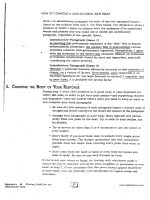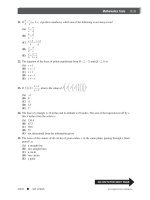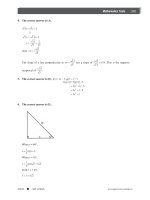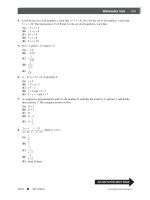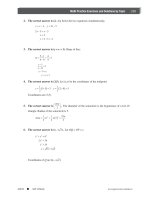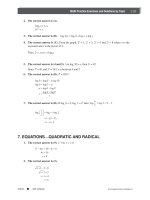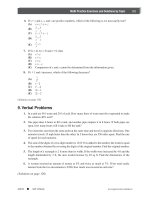SAT II Biology Episode 1 Part 3 doc
Bạn đang xem bản rút gọn của tài liệu. Xem và tải ngay bản đầy đủ của tài liệu tại đây (295.41 KB, 20 trang )
statistical statement, placing it somewhere in a “cloud”
surrounding the nucleus, depending on its energy state.
C. Atomic Number
The number of protons in an atom.
D. Atomic Mass
The number of protons and neutrons in the nucleus of an atom.
Electrons are not considered in this number. The actual number on
the periodic table is an average of the abundance of all the isotopes
of each element.
E. Isotope
Different form of an atom due to a different number of neutrons.
Carbon 12 has six neutrons, while Carbon 14 has eight neutrons.
Different isotopes of an element have slightly different properties that
are sometimes biologically important.
F. Ion
Electrically charged atom due to a loss (1 ion) or gain (− ion) of
electrons. An ionic bond is an attractive force of oppositely charged
ions by virtue of the loss/gain of electrons that takes place between
them. As atoms lose electrons and thus become positive, attraction
occurs with the atoms that gain electrons and thus become negative.
CHEMISTRY—ATOMS AND COMPOUNDS
37
Peterson’s n SAT II
Success: Biology E/M www.petersons.com
Some essential atoms
A. Hydrogen
Simplest element that has one proton and one neutron. It combines
with oxygen to form water, an essential abiotic substance for living
things.
B. Carbon
Ubiquitous element on this planet that forms the basis for all living
things. It can form the most number of bonds in chemical combina-
tions.
C. Nitrogen
Essential component of proteins and nucleic acids.
D. Oxygen
Necessary for aerobic respiration to take place and in the formation
of many organic molecules.
E. Phosphorous
Necessary for nucleic acid structure and in energy transformations.
Also important in membrane structure.
F. Sulfur
Forms sulfide bridges that are found in proteins.
CHAPTER 1
38
Peterson’s n SAT II
Success: Biology E/Mwww.petersons.com
MOLECULES
Molecules are a group of chemically combined atoms that are the
smallest form of a compound and have the properties of that com-
pound.
Compounds
Compounds are chemically combined atoms that form discreet
particles in which the atoms lose their individual physical properties,
and the compound, as a combined unit, takes on new properties.
Molecular bonds
Molecular bonds are the attractive forces of atoms by sharing elec-
trons or by gaining or losing electrons.
A. Covalent
Sharing of pairs of electrons between atoms that may result in single,
double, or triple bonds. A single bond, for example, results from the
sharing of one pair, thus the reference to “single.”
1. Nonpolar covalent—Covalent sharing is distributed symmetri-
cally within the molecule.
2. Polar covalent—Covalent sharing is distributed nonsymmetrically
within the molecule, resulting in weak positive and weak
negative charges.
B. Hydrogen bonds
Caused by polar covalent bonding, hydrogen bonds are the weak
attractions between slightly positive hydrogen atoms of a molecule
and slightly negative atoms, such as oxygen and nitrogen, of another
molecule.
CHEMISTRY—ATOMS AND COMPOUNDS
39
Peterson’s n SAT II
Success: Biology E/M www.petersons.com
C. Ionic bonds
Caused by electrons being pulled off one atom and bonded to the
atom that was attracting them.
Molecular forces
Molecular forces are forces that affect molecules, including the
following:
A. Van der Waals
Attractive forces that occur between electrically neutral molecules
because they are so close to each other.
B. Hydrophobic
Clumping together of molecules that are insoluble in water because
they are nonpolar.
Some molecules essential to life
A. Carbon Dioxide
Carbon and two oxygens bonded in a nonpolar, covalent orientation.
This is a highly oxidized, low energy form of carbon.
B. Oxygen molecule
Two atoms of oxygen bonded covalently. Molecular oxygen allows a
maximum oxidation of organic molecules in aerobic respiration.
C. Water
One oxygen and two hydrogen atoms bonded polar covalently.
Supplies the hydrogen and electrons to initiate the photosynthesis
process.
WATER
Water is the essential abiotic molecule for sustaining life. It is
essential in photosynthesis, in the maintenance of membranes, and as
the solvent for all of life’s molecules.
CHAPTER 1
40
Peterson’s n SAT II
Success: Biology E/Mwww.petersons.com
Structure
Two hydrogens with two single, covalent bonds with an oxygen atom
forming a polar molecule.
A. Shape
Orientation of the unbonded electrons in the oxygen and the protons
in the hydrogen orient them on “opposite sides of the molecule with
respect to each other.” The bond angles are approximately 105
degrees.
B. H1 bonds
Weak associations between the negative side of the water molecule
oxygen and the positive side that the hydrogens create; bonds that
hold water molecules together and result in high specific heat; good
solvent properties and cohesion that results in a substantial surface
tension.
Properties
Water has several unique properties.
A. Polar
The covalent bond orientation results in the slightly positive hydro-
gens being on one side of the molecule and the unequally unshared
electrons from oxygen more often on the other side of the molecule.
B. Cohesion
The dipole nature of the molecule produces bonds between the
positive hydrogens and the negative oxygen that, in sum, can be
substantial. The result is that water molecules tend to stick together,
resulting in a very high surface tension.
C. High Specific Heat
Because of the hydrogen bonds, water absorbs a large amount of heat
before it vaporizes.
CHEMISTRY—ATOMS AND COMPOUNDS
41
Peterson’s n SAT II
Success: Biology E/M www.petersons.com
D. Weak acid/base
Water has a neutral pH of 7.0 and normally dissociates into equal
amounts of H1 ions and OH
−
ions. It can, therefore, be a weak
proton donor (an acid) or a weak proton acceptor (a base).
ACIDS/BASES
Acids
Proton donor; when dissociated in aqueous solutions, acids become
sources of protons donated to the reaction.
Bases
Proton acceptor; when dissociated in aqueous solutions, bases
become proton acceptors in a reaction.
CHAPTER 1
42
Peterson’s n SAT II
Success: Biology E/Mwww.petersons.com
pH
pH is the measure of concentration of hydrogen ions in a solution.
The term stands for the percent concentration of hydrogen ions and
is the negative log of the concentration of hydrogen ions. Thus a
lower pH means a higher concentration of H1. (NOTE: Hydrogen
ions (H1) and protons are the same thing.) One may also take the
inverse of this concentration and thereby arrive at the concentration
of hydroxyl ions in solution.
CHEMISTRY—ATOMS AND COMPOUNDS
43
Peterson’s n SAT II
Success: Biology E/M www.petersons.com
BIOCHEMISTRY
CARBON
Carbon is the atom that is the basis for life on earth, owing to its
versatility. Carbon has four bonding electrons that make it capable of
forming many complex molecules. The chemistry of life is the
chemistry of carbon. The macro molecules of life are carbohydrates,
lipids, proteins, and nucleic acids.
Carbohydrates
Carbohydrates are macro molecules that organisms create for energy
storage, such as glycogen, or as structural components, such as
cellulose. Their basis is carbon, hydrogen, and oxygen in a 1:2:1 ratio,
thus the original term of hydrated carbon or carbohydrate.
CHAPTER 1
44
Peterson’s n SAT II
Success: Biology E/Mwww.petersons.com
A. Monosaccharides
Simple sugars made up of a backbone of usually three to seven
carbons with the formula of CH
2
O. When combined to produce
polysaccharides, they give off water at each bonding site in a reaction
known as dehydration synthesis.
1. Glucose—Preferred energy molecule of life. It is produced in
chloroplasts in the process of photosynthesis that stores energy
from the sun in organic molecules and is broken down in the
process of aerobic respiration that releases energy.
2. Fructose—Fruit sugar with the same molecular formula as
glucose but different structural formula. When combined with
glucose in a dehydration synthesis reaction, the two form
sucrose.
B. Disaccharide
Complex sugars formed from the union of two monosaccharides in a
condensation reaction.
Condensation
Condensation is also called dehydration synthesis. When two
monosaccharides bond together to form a disaccharide and a water
molecule is produced, then two hydrogens and one oxygen are
removed from the two simple sugars and form into a water molecule
in the process. Complex organic molecules are created by assembling
a small number of simple subunits in many different ways, analogous
to forming many words from the 26 letters of the alphabet. The
assembly of complex molecules from simple subunits is by so-called
“dehydration synthesis” or “condensation reactions” (the same thing).
When the small subunits are combined, a hydrogen atom (H) is
removed from one and a hydroxyl group (OH) from the next. These
atoms combine to make a water molecule (HOH), and the subunits
become covalently bonded. The opposite process is called hydrolysis
(water splitting) and releases the simple subunits from the molecule.
This occurs, for example, during digestion.
Hydrolysis
Hydrolysis is the opposite of condensation; it occurs when carbohy-
drates, for example, are metabolized. Two hydrogens and one oxygen
are ultimately inserted into the polysaccharide to cleave it into two
simpler carbohydrates. For each cleavage, one water molecule is
needed.
CHEMISTRY—ATOMS AND COMPOUNDS
45
Peterson’s n SAT II
Success: Biology E/M www.petersons.com
A. Polysaccharide
Carbohydrate formed from a number of simple sugars; the typical
storage and structural form of carbohydrate in autotrophs. Polysaccha-
rides are less diverse than DNA or proteins and are often long chains
of a single monosaccharide, such as glucose (e.g., starch, cellulose,
and glycogen).
1. Starch—Plant polysaccharide that is almost insoluble in water. In
autotrophs, glucose may be quickly converted to starch in order
to conserve glucose, which is soluble in water.
2. Cellulose—Largest carbohydrate molecule is insoluble in water
and can be metabolized primarily by bacteria and fungi. An
autotroph structural molecule, it is nonetheless important to
heterotrophs in that it aids in digestion.
3. Glycogen—The heterotroph analog to starch, it is used to store
energy in animals.
Proteins
One of the main structural as well as functional molecules in living
systems, protein comes from chains of amino acids bonded together.
It is found embedded in plasma membranes, acting as a catalyst, or as
part of the structural integrity of many parts of living systems. In
addition to the C, H, N, and O mix of living systems, they also
contain S. Proteins are assembled from 20 different amino acids.
A. Amino acids
Main building block of polypeptides.
1. Backbone—Amino acids are built around a carbon center that
has a hydrogen attached to one of the four covalent bonds of the
central carbon.
2. R-group—Occupies a second of the four covalent bonds of the
central carbon and can be as simple as a hydrogen or a complex
ringed structure. There are 20 R-groups on the 20 amino acids
that combine to form proteins.
CHAPTER 1
46
Peterson’s n SAT II
Success: Biology E/Mwww.petersons.com
3. Carboxyl group—COOH complex attached to a third spot on the
central carbon.
4. Amine group—NH complex attached to the fourth covalent
bond on the central carbon.
B. Polypeptides
Built up of strings of two or more amino acids that are bonded
together as a result of condensation.
C. Protein structures
Four different ways in which proteins are structured:
1. Primary—The number, type, and sequence of amino acids
forming a linear structure.
2. Secondary—Repetition of amino acid sequences and, therefore,
bond angles that give the linear primary structure molecule a
repeating structural pattern.
3. Tertiary—Folding pattern of the chain that relates to the
underlying secondary structure and gives the molecule a three-
dimensional shape.
4. Quaternary—Fitting together of two or more independently
folded polypeptides that conform to each other to provide a
functional protein.
Lipids
Lipids are molecules that store the most energy for living systems;
also made up of C, H, and O that are not in a 1:2:1 ratio. Lipids are
insoluble in water but soluble in nonpolar substances. Fats are
examples that have three fatty acid residues attached to a glycerol
backbone. Lipids are often assembled from fatty acids and an alcohol.
CHEMISTRY—ATOMS AND COMPOUNDS
47
Peterson’s n SAT II
Success: Biology E/M www.petersons.com
A. Fats
Three fatty acids bonded at their carboxyl site to the hydroxyl site in
a molecule of glycerol and often referred to as a triglyceride. They are
either saturated and contain all single covalent bonds between carbon
atoms in the fatty acids or are unsaturated and contain at least one
double covalent bond.
B. Oils
Esters of open-chain hydrocarbons that are liquid at room tempera-
ture. An ester is usually formed by the reaction between an acid and
an alcohol with elimination of water.
C. Waxes
Esters of long chain fatty acids and long chain alcohols. They have
low melting points but are solids at room temperature.
D. Steroids
Fashioned on a backbone of four linked carbon rings and include
cholesterol and hormones.
E. Phospholipids
Composed of two fatty acids (the hydrophobic side of the molecule)
and a phosphate group (the hydrophilic side of the molecule). Found
in plasma membranes of cells as two layers of molecules (bilayer)
CHAPTER 1
48
Peterson’s n SAT II
Success: Biology E/Mwww.petersons.com
where the hydrophobic ends are oriented to both the inside of the
bilayer and the outside of the bilayer.
Nucleic Acids
Nucleic acids control molecules of life that contain or carry the codes
for all the molecules that a particular cell needs. In addition, they
carry the code for making new cells of a like kind—the key to
heredity. Their building blocks are known as nucleotides and are
composed of a 5-carbon sugar, a phosphate group, and a nitrogenous
base. Their almost infinite variability lies in the unique sequences of
their nucleotides. RNA and DNA are two types of nucleic acids.
CHEMISTRY—ATOMS AND COMPOUNDS
49
Peterson’s n SAT II
Success: Biology E/M www.petersons.com
A. DNA (double helix)
Nucleic acid that contains the 5-carbon sugar known as deoxyribose,
which denotes less oxygen than the ribose sugar. This molecule is the
basis for genes and chromosomes. DNA is assembled from only four
nucleotides (adenine, thymine, cytosine, guanine), but the code is
millions of nucleotides long.
-
-
CHAPTER 1
50
Peterson’s n SAT II
Success: Biology E/Mwww.petersons.com
B. RNA (single stranded)
Nucleic acid that contains the 5-carbon sugar known as ribose, which
denotes more oxygen than the deoxyribose sugar. It is the molecule
that carries the DNA code to the ribosome in cells and helps in
fashioning proteins. In the code, uracil replaces thymine in RNA.
CHEMICAL REACTIONS
Interactions among chemicals fall into five categories and are charac-
terized by an alteration of the structures involved as well as their
energy levels. An organism that is properly nourished has the
atoms/molecules it needs. The information for its complexity comes
from DNA. The energy comes from manipulating oxidation/reduction
reactions. Oxidation is the loss of electrons and, therefore, the loss of
the energy of those electrons. In biological systems, this is usually the
result of adding oxygen to a molecule or removing hydrogen. In
cellular respiration, energy is removed from organic molecules by
removing hydrogen atoms. Carbon is discarded in its most oxidized
form, CO
2
. Reduction is the opposite of oxidation. Thus, every
chemical reaction oxidizes something and reduces something else.
Reduction can be the loss of oxygen or the gain of hydrogen.
Biological molecules are highly reduced and, therefore, have lots of
hydrogens and are complex. The business of being alive is to main-
tain reduced molecules in an oxidizing environment. In other words,
we eat to stay reduced.
Synthesis
The combination of two or more substances (atoms or molecules)
that results in the making of another substance unlike the original
components.
Decomposition
Breakdown of a substance into its component parts; it is the opposite
of synthesis.
Single replacement
One part of a substance is replaced by another.
Double replacement
Similar to single replacement, except the exchange results in two
new compounds as a result of the replacement in two substances,
not one.
CHEMISTRY—ATOMS AND COMPOUNDS
51
Peterson’s n SAT II
Success: Biology E/M www.petersons.com
Equilibrium
Results when conditions produce no net changes in amounts of
reactants and products. This can be altered by the addition of
reactants, products, or any one of a number of physical aspects of the
reaction, such as temperature or acidity.
Free energy
Becomes available for work as a result of a reaction.
A. Exergonic
Release of energy during a reaction that is spontaneous.
B. Endergonic
Absorption of energy during a reaction that is nonspontaneous.
Enzyme
Organic catalysts (completely or partially proteins) that alter the
amount of energy needed to initiate a reaction, usually accelerating a
reaction. They take part in the reaction but are not altered by it.
Coenzyme
Works with an enzyme to complete the catalytic reaction and consists
of either a metal or nonprotein organic molecules. Vitamins can be
coenzymes.
Co-factor
Any organic or inorganic substance that is needed for the operation
of an enzyme.
CHAPTER 1
52
Peterson’s n SAT II
Success: Biology E/Mwww.petersons.com
MULTIPLE-CHOICE QUESTIONS
1. In the reaction rate versus substrate concentration graph below,
the curve plateaus because
(A) a noncompetitive inhibitor is present.
(B) a competitive inhibitor is present.
(C) all the substrate has been converted to product.
(D) the active site is saturated with substrate.
(E) the cofactor is locked in an inactive conformation.
2. Which of the following terms does NOT refer to an example of a
weak force of interaction between two molecules?
(A) covalent bond
(B) Van der Waals bond
(C) hydrophobic bond
(D) electrostatic bond
(E) hydrogen bond
3. The element found in all amino acids that is NOT found in
carbohydrates is
(A) sulfur.
(B) carbon.
(C) oxygen.
(D) hydrogen.
(E) nitrogen.
CHEMISTRY—ATOMS AND COMPOUNDS
53
Peterson’s n SAT II
Success: Biology E/M www.petersons.com
4. Which of the following would NOT have hydrophilic properties?
(A) OH
(B) molecules in aqueous solution
(C) long hydrocarbon chains
(D) ionized molecules
(E) polar molecules
5. Which if the following is NOT found in DNA?
(A) uracil
(B) thymine
(C) phosphate
(D) adenine
(E) deoxyribose sugar
6. Elements used for making molecules found in living systems must
(A) contain nitrogen and sulfur.
(B) be hydrophilic.
(C) be covalent.
(D) be water soluble and ionic.
(E) be suitable and available.
7. Which of the following is NOT a property of water?
(A) hydrophilic properties
(B) hydrophobic properties
(C) very good solvent
(D) density as a solid is less than that as a liquid
(E) strong surface tension
8. Which of the following are weak forces usually associated with
biological molecules?
(A) hydrogen bonds
(B) electrostatic interactions
(C) covalent bonds
(D) ionic bonds
(E) both (A) and (B)
CHAPTER 1
54
Peterson’s n SAT II
Success: Biology E/Mwww.petersons.com
9. Which arrow(s) point to a peptide bond?
(A) 1
(B) 1 and 4
(C) 2
(D) 3
(E) 2 and 5
10. A polypeptide that is ten amino acid units long is split into
several small fragments, and the sequences of some of the
fragments are discovered. The fragments are lys-trp-arg, lys-asp-
ala-gly, pro-gln-his-lys, and arg-pro-gln. What was the primary
source of the polypeptide?
(A) ala-gly-ser-gln-lys-trp-arg-pro-gln-his
(B) asp-ala-gln-ser-gln-his-lys-trp-arg-pro
(C) ala-gly-pro-gln-his-lys-trp-arg-pro-asp
(D) lys-trp-arg-pro-gln-his-lys-asp-ala-gly
(E) gly-ala-asp-lys-his-gln-pro-arg-trp-lys
EXPLANATION OF ANSWERS FOR MULTIPLE-CHOICE QUESTIONS
1. The correct answer is (D). A reaction in which the enzyme is
the catalyst may be written as follows:
Enzyme 1 Substrate ↔ Enzyme-Substrate complex ↔ Enzyme 1
Product
The substrate binds to a specific site on the surface of the
enzyme, known as the active site, after which product and
enzyme are released. The enzyme is then available to bind
another substrate. At low substrate concentration, the reaction
rate increases sharply with increasing substrate concentration
because there are abundant free enzyme molecules available to
bind to an added substrate. At high substrate concentration, the
reaction rate reaches a plateau as the enzyme active sites become
CHEMISTRY—ATOMS AND COMPOUNDS
55
Peterson’s n SAT II
Success: Biology E/M www.petersons.com
saturated with substrate. The enzyme-substrate complex and no
free enzymes are available to bind the added substrate.
2. The correct answer is (A). All of the choices except choice (A)
are weak forces in biological systems. Covalent bonds involve a
sharing of electrons, which leads to a strong interaction between
molecules. In large numbers, some of the forces listed can
produce strong binding in molecules, but taken individually, they
cannot compare to the strength of a covalent bond.
3. The correct answer is (E). Amino acids derive their name from
the amine group that bonds to one of the four covalent bonds of
the central carbon atom. The amine group consists of one
nitrogen and two hydrogens and is found in all molecules known
as amino acids. The amine group forms a peptide bond with the
COOH complex of an adjoining amino acid in the construction of
a polypeptide.
4. The correct answer is (C). Any substance with electrical
charges will exhibit hydrophilic or “water loving” properties and
interact with water forming hydrogen bonds. Ionized molecules
are charged molecules, as are polar molecules. The long hydro-
carbon chains on molecules of that nature distribute any charge
they might have uniformly over the chain, thus rendering the
chain nonpolar and thus nonresponsive to the polar nature of
water necessary for hydrophilic properties in the molecule.
5. The correct answer is (A). Choices (B) through (E) are all
present in DNA. Thymine and adenine are two DNA bases and
make up one of the three components of nucleic acids, namely
nucleotides. These consist of a base, a 5-carbon sugar, and a
phosphate group. The sugar in DNA lacks an oxygen and is
called deoxyribose sugar. Uracil is unique to RNA, as is the
5-carbon ribose sugar not listed here.
6. The correct answer is (E). All of the choices listed are found in
one or more biologically significant molecules, but choice (E)
must be true of all biologically significant molecules. They must
be correct for the “job,” and they must be within reach of the
living system that needs them. Not all molecules contain nitrogen
and sulfur, nor are they attracted to water. In addition, they are
not all covalent substances.
7. The correct answer is (B). Choice (B) translates to “water
fearing” and, therefore, is a logical impossibility since it would
describe water as not binding with water. The hydrophobic as
well as the hydrophilic nature of a molecule is used to describe
the interaction another molecule has with water. More impor-
tantly, it describes a situation that would not have a polar nature,
which water does. Hydrophilic would be explained by the
CHAPTER 1
56
Peterson’s n SAT II
Success: Biology E/Mwww.petersons.com

